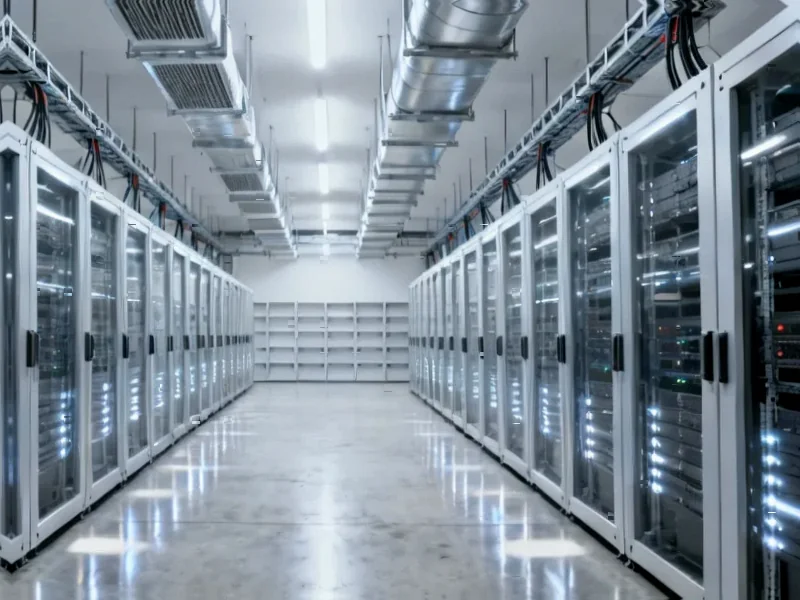According to TechCrunch, Microsoft CEO Satya Nadella and OpenAI CEO Sam Altman revealed on the BG2 podcast that the AI industry faces an unprecedented power constraint crisis. Nadella admitted Microsoft has ordered too many AI chips for the power it has contracted, leaving chips sitting idle without “warm shells” – data center buildings ready for deployment. Altman warned that AI compute costs have been falling at an average rate of 40x per year for given intelligence levels, creating “a very scary exponent from an infrastructure buildout standpoint.” Both executives expressed uncertainty about future power needs, with Altman investing in nuclear startups Oklo and Helion while warning that companies could face significant losses if cheaper energy emerges or demand patterns shift unexpectedly.
The Infrastructure Mismatch Crisis
The fundamental challenge facing AI companies represents a collision between digital and physical worlds. For decades, technology companies operated in environments where scaling meant adding servers or cloud capacity – assets that could be provisioned in weeks or months. Now they’re confronting energy infrastructure timelines measured in years. This creates a dangerous planning gap where AI model improvements and market demand can shift dramatically while power plants and transmission infrastructure remain static. The situation is particularly acute for hyperscalers who must make billion-dollar bets on energy infrastructure based on AI adoption projections that could be obsolete by the time construction completes.
Stakeholder Impact and Market Consequences
This power constraint creates clear winners and losers across the technology ecosystem. Large cloud providers with established energy procurement teams and existing data center footprints hold significant advantages, while startups and research institutions face potential exclusion from cutting-edge AI development due to energy costs and availability. Geographic disparities will intensify as regions with abundant, affordable power become strategic assets while areas with constrained grids see innovation stall. Enterprises planning AI transformations must now factor energy availability into their roadmaps, potentially delaying projects not just for technical reasons but for literal power constraints. As Nadella indicated in the podcast discussion, the problem has shifted from chip supply to physical infrastructure readiness.
The Jevons Paradox Dilemma
Altman’s reference to efficiency improvements driving greater overall consumption points to a deeper economic reality that could undermine current planning assumptions. As Jevons Paradox explains, when technology makes a resource more efficient, total consumption often increases rather than decreases. In AI’s case, each efficiency breakthrough in model architecture or chip design doesn’t reduce overall energy demand – it enables new applications and use cases that consume the saved capacity and more. This creates a planning nightmare for infrastructure investors who must bet billions on demand projections that could be completely upended by the next algorithmic breakthrough.
The Race for Energy Innovation
The current scramble for power solutions reveals how technology companies are being forced into unfamiliar territory. Solar deployment offers short-term relief due to its modular nature and declining costs, but intermittent availability limits its utility for always-on AI workloads. Nuclear investments represent long-term bets that won’t address immediate constraints. Meanwhile, the rush toward behind-the-meter power arrangements creates a fragmented energy landscape where AI companies effectively become utility companies, diverting resources from their core missions. This energy innovation race will likely create new business models around power procurement and management, with energy availability becoming a competitive advantage as valuable as algorithm quality.
Strategic Implications for AI Development
The power constraint fundamentally changes how we should think about AI progress. Rather than being limited by theoretical breakthroughs or algorithmic innovation, practical deployment may be constrained by physical infrastructure. This could lead to increased focus on energy-efficient model architectures and specialized hardware optimized for power consumption rather than pure performance. It also suggests that the next phase of AI competition may be won not in research labs but in boardrooms negotiating power purchase agreements and navigating regulatory approvals for energy projects. Companies that master both the digital and physical aspects of this challenge will have significant advantages in bringing AI applications to market.




